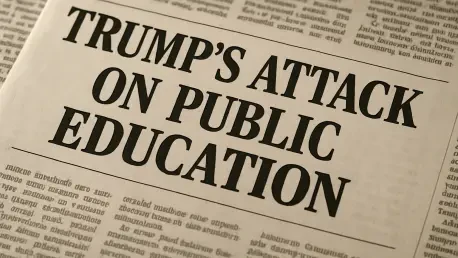The American public education system, long regarded as a pillar of democracy and a pathway to opportunity for millions, stands at a precarious crossroads under the current policies of the Trump administration. As this analysis explores the implications of a hypothetical second term, it becomes evident that an aggressive agenda to reshape federal involvement in K-12 education is unfolding with profound consequences. This shift prioritizes reducing federal oversight, promoting privatization through school choice programs, and redirecting resources in ways that challenge the core principles of equity and accessibility. With initiatives aimed at dismantling key federal structures and favoring state control, the administration’s approach raises urgent questions about the future of public schools, which serve as a vital common good. How will these policies impact the students most reliant on public education for their chance at a better life? This critical examination seeks to unpack the specific measures being pursued, analyze their broader implications, and shed light on the potential long-term effects on a system designed to educate all, regardless of background or circumstance. By delving into the nuances of these changes, the goal is to provide a comprehensive understanding of a transformation that could redefine the educational landscape for generations.
Dismantling Federal Oversight
The Trump administration’s clear intent to scale back federal involvement in education marks a significant departure from longstanding national policy. At the forefront of this agenda is a plan to dismantle the Department of Education, a move championed by President Trump and echoed by figures such as Secretary of Education Linda McMahon. Recent executive actions have already led to substantial reductions in staff and funding, severely limiting the department’s ability to support state and local education agencies. This systematic erosion of federal capacity not only undermines the enforcement of educational standards but also signals a broader ideological shift toward decentralization. Critics argue that such drastic measures weaken the federal government’s role in ensuring consistent quality across diverse regions, leaving many to question how states will manage without adequate federal backing. The implications of this policy extend beyond mere administrative changes, touching on the very foundation of how education is governed and prioritized in the nation.
Beyond the structural dismantling, the reduction in federal oversight directly impacts programs designed to support the most vulnerable student populations. Funding cuts have targeted initiatives for low-income families and students with special needs, placing an increased financial burden on states already grappling with budget constraints. The diminished capacity to monitor compliance with federal education laws further exacerbates these challenges, as states may struggle to fill the gaps left by retreating federal support. This shift risks creating a patchwork of educational quality, where disparities between well-funded and under-resourced districts become even more pronounced. As federal guidance and resources dwindle, the ability to maintain equitable access to education for all students hangs in a delicate balance, highlighting a critical tension between state autonomy and national responsibility.
The Push for Privatization and School Choice
Central to the administration’s education policy is a robust emphasis on school choice programs, which redirect taxpayer funds toward private and religious institutions. Legislation such as the “One Big Beautiful Bill” (OBBB), slated for implementation in 2027, alongside the proposed Educational Choice for Children Act (ECCA), introduces tax credit scholarships as a mechanism to incentivize private schooling. Proponents frame these initiatives as empowering parental choice, allowing families to select educational environments that best suit their children’s needs. However, detractors point to a significant lack of oversight in how these funds are allocated, raising alarms about accountability. With potentially billions of dollars diverted over the coming decade, the focus on privatization appears to prioritize individual preference over the collective strength of public education, sparking a heated debate about the role of taxpayer money in supporting non-public entities.
Critics of these school choice programs highlight their potential to serve as tax shelters for wealthier families rather than as genuine opportunities for broader access. The structure of vouchers and scholarships often fails to cover the full cost of private school tuition, meaning only those with additional financial means can truly benefit. This dynamic risks draining essential resources from public schools, which are legally obligated to serve all students regardless of background or ability. The emphasis on privatization also overlooks the systemic challenges facing public education, such as the need for better infrastructure and qualified educators. As funds are siphoned away, the capacity of public schools to address these pressing issues diminishes, leaving behind a system that struggles to meet the needs of the majority while catering to a select few.
Undermining Equity and Civil Rights Protections
Equity in education faces severe threats under the current administration’s policies, with significant reductions in programs aimed at fostering diversity, equity, and inclusion (DEI). Budget cuts have targeted initiatives that address racial justice and support for marginalized groups, reflecting a broader rollback of federal commitment to equal access. The Office for Civil Rights, responsible for enforcing anti-discrimination laws in schools, has seen its operational capacity slashed, limiting its ability to investigate and address violations effectively. This reduction sends a troubling message about the priority placed on protecting students from discrimination based on race, gender, or other factors. As federal safeguards weaken, the risk of systemic inequities becoming entrenched in the educational landscape grows, challenging the principle that every child deserves an equal opportunity to learn and succeed.
Adding to these concerns is the reality faced by private schools that receive public funds through school choice programs. Unlike public institutions, many of these schools retain legal leeway to discriminate on grounds such as religion, gender identity, or disability, often citing insufficient infrastructure or alignment with their mission. This lack of accountability stands in stark contrast to the mandates public schools must follow, creating a dual system where some students are systematically excluded under the guise of institutional autonomy. The erosion of civil rights protections in education not only jeopardizes the well-being of vulnerable students but also undermines the societal value of an inclusive education system. Without robust federal enforcement, the promise of education as a great equalizer becomes increasingly hollow for those already facing significant barriers.
Widening Socioeconomic Disparities and Accountability Gaps
The socioeconomic divide in education is poised to widen under policies that favor school choice, often benefiting families already enrolled in private schools rather than those seeking alternatives to underperforming public ones. Evidence from states like Arkansas reveals that a vast majority of voucher recipients were not previously in public schools, suggesting these programs primarily subsidize the affluent rather than uplift the disadvantaged. For lower-income families, the partial funding provided by vouchers and scholarships frequently falls short of covering full tuition costs at private institutions, rendering the supposed choice inaccessible. This dynamic perpetuates a cycle of inequality, where access to quality education increasingly correlates with financial means, leaving public schools—where most economically disadvantaged students remain—further under-resourced and overstretched.
Transparency and accountability represent additional casualties of this policy shift, particularly with tax credit scholarships managed outside traditional education oversight structures. Unlike public schools, which are bound by stringent reporting requirements for taxpayer funds, scholarship-granting organizations and the private schools they support face minimal obligations to disclose how money is used or to measure student outcomes. This opacity, often overseen by entities like the Treasury Department rather than education specialists, heightens risks of mismanagement, waste, or even fraud. The absence of clear accountability mechanisms not only undermines public trust but also raises fundamental questions about the stewardship of funds intended for educational purposes, leaving taxpayers and students alike vulnerable to exploitation.
Challenges to Church-State Separation
A significant concern arising from the administration’s education policies is the use of public funds to support religious schools, a practice upheld by recent Supreme Court decisions but still contentious under the First Amendment’s Establishment Clause. The ambiguity surrounding federal tax credit programs, such as those proposed in upcoming legislation, fuels uncertainty about whether all religious groups will be treated equitably or if certain affiliations will be favored. With oversight potentially falling to non-educational agencies like the Treasury, the lack of clear guidelines exacerbates fears of bias or unequal application. This situation poses a direct challenge to the constitutional principle of separating church and state, stirring legal and ethical debates about the role of public money in religious education and its broader implications for a pluralistic society.
Public education’s historic role as a unifying force—promoting economic vitality, democratic engagement, and social cohesion—stands at odds with the current push toward privatization. Rather than investing in public schools to ensure access to high-quality teachers, safe learning environments, and adequate resources, the redirection of funds to religious and private institutions risks neglecting the needs of students in rural and low-income areas who depend on public systems for opportunity. This shift threatens to erode the common good that public education represents, prioritizing individual or sectarian interests over collective progress. As these policies unfold, the tension between personal choice and societal responsibility becomes a defining struggle, with lasting consequences for how education serves as a foundation for national unity and advancement.
Reflecting on the Path Forward
Looking back, the Trump administration’s approach to public education sparked intense debate over the balance between federal oversight, state autonomy, and privatization. The moves to dismantle key federal structures, slash equity programs, and channel funds into school choice initiatives left an indelible mark on the discourse surrounding K-12 schooling. These policies, characterized by deep cuts and a reorientation toward private and religious institutions, highlighted a fundamental clash of values about the purpose of education in society. The erosion of accountability and civil rights protections underscored the challenges faced by a system meant to serve every child, regardless of circumstance.
Moving forward, addressing these challenges requires a renewed focus on strengthening public schools as engines of opportunity and equality. Policymakers and educators must prioritize investments in teacher training, infrastructure improvements, and resources for underserved communities to close persistent gaps. Establishing rigorous oversight for any public funds directed to private entities should be a non-negotiable step to ensure transparency and fairness. Additionally, reinforcing federal protections for civil rights in education can help safeguard against discrimination and exclusion. As the nation navigates this evolving landscape, a commitment to public education as a shared responsibility—rather than a fragmented privilege—offers the most promising path to preserving its role as a cornerstone of democracy and progress for future generations.









